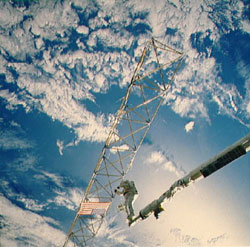
Chapter Links
Home
Members
Events
Projects
Gallery
Educational Outreach
Donations and Sponsors
Current Weather Reports
So you want to be an Astronaut
Mars Links
Mars Society Links
Mars Society
Founding Declaration
Mars Desert Research Station
Flashline Mars Arctic Research Station
Sign the Mars Petition
Requests concerning this Web site should be directed to the Webmaster.
General queries should be directed to MarsSocInfo@aol.com
Copyright © 2001 The Mars Society. All rights reserved.
|
NASA Information Summaries PMS-033 (JSC) Wardrobe for Space Part Two: Wardrobe for the space shuttle era (cont.) |
|||
|
All fabric-to- hardware connections are made with either mechanical joints or adhesive bonding. Materials used in the construction of the suit are selected to
prevent fungus or bacteria growth; however, the suit must be cleaned and dried after flight use.
The entire suit assembly is rated with a minimum 8-year life expectancy. The nominal operating atmospheric pressure in the suit is 4.3 psid. The suit comprises several layers including a polyurethane-coated nylon pressure bladder, a polyester structural restraint layer with folded and pleated joints (for mobility), and a woven Kevlar, Teflon, and Dacron anti-abrasion outer layer. The maximum total weight of the largest size spacesuit assembly, including the liquid cooling and ventilation garment, urine collection device, helmet and visor assembly, communications carrier assembly, insuit drink bag, and biomedical instrumentation subsystem, is 107 pounds, The astronaut is ready to go to work in space and secures the necessary tools to the mini-workstation of the suit. The EMU lights are mounted on the helmet and are a necessity because during orbital operations approximately every other 45 minutes are spent in darkness.
The extravehicular communicator attaches to the upper portion of the life support system at the back of the hard upper torso, The controls are located on the display and control module mounted on the chest at the front of the upper torso. The extravehicular communicator provides radio communication between the suited crewmember and the orbiter. In addition, electrocardiographic (EKG) information is telemetered through the extravehicular communicator to the orbiter and to flight surgeons in the Mission Control Center at Houston, Texas. |
|
||
|
Continue Part Two: Wardrobe for the space shuttle era |
|||
